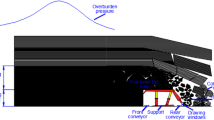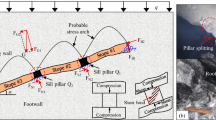Abstract
In underground coal mining, the working face end is a bridge connecting the stope and the roadway. It not only is characterized by a large area pressure, but also faces the problems of rib spalling, roof falling, and floor heaving. In this research, a 3313 gob side entry retaining in fully mechanized top coal caving face in Shanxi Province was taken as the study object. First, by setting up stress sensors in the goaf, the soft mold filling body, and single pillars at the working face end, their stress changes were respectively monitored. It was concluded that the stress recovery process of the goaf behind the working face end is characterized by periodic step growth, and the roof above the goaf at the working face end is broken layer by layer. The simulation means of 3DEC system was subsequently used to simulate the changes in the stress and displacement of the 3313 working face end. The results demonstrate that the failure of the roof at the end of the goaf also exhibits periodicity. Finally, a thin-plate mechanics model before the first failure of the roof of the working face end was established, and the deflection distribution characteristics of the thin plate under six different length-to-width ratios were compared and analyzed. The research results of this study have important practical significance for deeply understanding the failure mechanism of the roof at the working face end and give a guarantee of the safe and efficient exploitation of coal mining.
Article Highlights
-
The stress evolution of coal goaf was investigated via field measurements.
-
The roof collapse and dynamic evolution of three-dimensional mining stress were investigated via numerical simulation.
-
The mechanism of roof failure at the working face end was discussed.












Similar content being viewed by others
Data availability
The data used to support the findings of this study are available from the corresponding author upon request.
References
Badr S (2002) Numerical analysis of coal yield pillars. Ph.D. thesis. Mining Engineering Department, Colorado School of Mine, p 188
Badr S, Ozbay U, Kieffer DS, Salamon M (2003) Three-dimensional strain softening modeling of deep longwall mine layouts. In: FLAC and numerical modeling in geomechanics
Bai QS, Tu SH, Wang F (2014) Observation and numerical analysis of the scope of fractured zones around gateroads under longwall influence. Rock Mech Rock Eng 47(5):1939–1950
Boothukuri VR, Bhattacharjee RM, Panigrahi DC et al (2019) Impact of geo technical factors on strata behavior in longwall panels of Godavari Valley coal field—a case study. Int J Min Sci Technol 29:335–341
Bieniawski ZT (1973) Engineering classification of jointed rock masses. Civ Eng S Afr 15:335–343
Bieniawski ZT (1978) Determining rock mass deformability: experience from case histories. Int J Rock Mech Min Sci Geomech Abstr 15(5):237–247
Bieniawski ZT (1989) Engineering rock mass classifications. Wiley, New York
Brady BHG, Brown ET (2006) Rock mechanics for underground mining, 3rd edn. Springer, Dordrecht
Chen J, Zhou L, Xia B et al (2021) Numerical investigation of 3D distribution of mining-induced fractures in response to longwall mining. Nat Resour Res 30:889–916
Cheng G, Yang T, Liu H et al (2020) Characteristics of stratum movement induced by downward longwall mining activities in middle-distance multi-seam. Int J Rock Mech Min Sci 136:104517
Cundall PA (1971) The measurement and analysis of acceleration in rock slopes. Dissertation: University of London, Imperial College of Science and Technology
Du F, Wang K (2019) Unstable failure of gas-bearing coal-rock combination bodies: insights from physical experiments and numerical simulations. Process Saf Environ Prot 129:264–279
Du F, Wang K, Zhang X et al (2020) Experimental study of coal-gas outburst: insights from coal-rock structure, gas pressure and adsorptivity. Nat Resour Res 29:2481–2493
Goriupp K (1947) Die dreiseitig gelagerte Reckteckplatte. Arch Appl Mech 16:153–163
Guo P, Wang T, Li D et al (2016) How energy technology innovation affects transition of coal resource-based economy in China. Energy Policy 92:1–6
He Z, Xie H, Gao M et al (2021) The fracturing models of hard roofs and spatiotemporal law of mining-induced stress in a top coal caving face with an extra-thick coal seam. Geomech Geophys Geo-Energy Geo-Resour 7:2
Jiang L, Wu Q, Li X, Ding N (2017) Numerical simulation on coupling method between mining-induced stress and goaf compression. J China Coal Soc 42(08):1951–1959
Ju M, Wang D, Shi J et al (2021) Physical and numerical investigations of bedding adhesion strength on stratified rock roof fracture with longwall coal mining. Geomech Geophys Geo-Energy Geo-Resour 7:24
Ju J, Xu J (2015) Surface stepped subsidence related to top-coal caving longwall mining of extremely thick coal seam under shallow cover. Int J Rock Mech Min Sci 78:27–35
Kang H, Wu L, Gao F et al (2019) Field study on the load transfer mechanics associated with longwall coal retreat mining. Int J Rock Mech Min Sci 124:104141
Kang H, Lou J, Gao F et al (2018) A physical and numerical investigation of sudden massive roof collapse during longwall coal retreat mining. Int J Coal Geol 188:25–36
Liu L, Cheng L, Zhao L et al (2020) Investigating the significant change of coal consumption in China in 2002–2017. Energy 207:118307
Pappas DM, Mark C (1993) Behavior of simulated longwall gob material. US Bureau of Mines
Qian M, Shi P, Xu J (2010) Mining pressure and strata control. China University of Mining and Technology Press, Xuzhou
Qin Z, Guo H, Qu Q (2019) Investigation of effect of barometric pressure on gas emission in longwall mining by monitoring and CFD modelling. Int J Coal Geol 205:32–42
Serafim JL, Pereira JP (1983) Considerations on the geomechanical classification of bieniawski. In: Proceedings of international symposium on engineering geology and underground openings, Lisbon, Portugal, pp 1133–114
Shang Z, Tang S, Jiao W et al (2014) Failure probability of goaf in large-scale based on simulation of FLAC3D. Rock Soil Mech 35(10):3000–3006
Suchowerska A, Merifield R, Carter J (2013) Vertical stress changes in multi-seam mining under supercritical longwall panels. Int J Rock Mech Min Sci 61:306–320
Timoshenko S, Woinowsky-krieger S (1959) Theory of plates and shells. McGraw-Hill Inc, p 213
Wang F, Jiang B, Chen S et al (2019) Surface collapse control under thick unconsolidated layers by backfilling strip mining in coal mines. Int J Rock Mech Min Sci 113:268–277
Wang H, Fang X, Du F et al (2021) Three-dimensional distribution and oxidation degree analysis of coal gangue dump fire area: a case study. Sci Total Environ 772:145606
Wang J, Kong S, Kong D et al (2016) Failure mechanism and control technology of longwall coalface in large-cutting-height mining method. Int J Min Sci Technol 26:111–118
Wang K, Du F (2020) Coal-gas compound dynamic disasters in China: a review. Process Saf Environ Prot 133:1–17
Wang S, Mao D, Pan J et al (2015) Measurement on the whole process of abutment pressure evolution and microseismic activities at the lateral strata of goaf. J China Coal Soc 40(12):2772–2779
Wang Y, He M, Yang J et al (2020) Case study on pressure-relief mining technology without advance tunneling and coal pillars in longwall mining. Tunnel Undergr Space Technol 97:103236
Wei C, Zhang C, Canbulat I (2020) Numerical analysis of fault-slip behaviour in longwall mining using linear slip weakening law. Tunnel Undergr Space Technol 104:103541
Xin C, Du F, Wang K et al (2021) Damage evolution analysis and gas–solid coupling model for coal containing gas. Geomech Geophys Geo-Energy and Geo-Resour 7:7
Yavuz H (2004) An estimation method for cover pressure reestablishment distance and pressure distribution in the goaf longwall coal mines. Int J Rock Mech Min Sci 41(2):193–205
Zhao J, Zhang Y (2017) Studies on rock failure of layered rock in underground mining-face and control techniques. Geomech Geophys Geo-Energy Geo-Resour 3:405–414
Zhang G, Zhang Y (2018) The immediate roof first fractures of suberect and extremely thick coal. J China Coal Soci 43(05):1220–1229
Zhang X, Ma J, Li L (2020) Monitoring of coal-mine goaf based on 4D seismic technology. Appl Geophys 17:54–66
Zhu G, Liu B, Dou L et al (2019) Numerical simulation for whole press of longwall mining on the basis of goaf compaction effect. J China Univ Min Technol 48(04):775–783
Acknowledgements
This research was funded by the State Key Research Development Program of China (2018YFC0604501), the Science and Technology Innovation Project of China Energy Investment Corporation (SHGF-16-24, SHJT-17-38), the National Natural Science Foundation of China (52004291, 51974161), the State Key Laboratory Cultivation Base for Gas Geology and Gas Control (Henan Polytechnic University) (WS2020A04).
Author information
Authors and Affiliations
Contributions
GZ: Methodology, investigation, writing-original draft. QL: Investigation, Writing-original draft. YZ: Formal analysis, writing-review and editing. FD: conceptualization, formal analysis, writing-review and editing.
Corresponding authors
Ethics declarations
Conflict of interest
The authors declare that they have no known competing financial interests or personal relationships that could have appeared to influence the work reported in this paper.
Additional information
Publisher's Note
Springer Nature remains neutral with regard to jurisdictional claims in published maps and institutional affiliations.
Rights and permissions
About this article
Cite this article
Zhang, G., Li, Q., Zhang, Y. et al. Failure characteristics of roof in working face end based on stress evolution of goaf. Geomech. Geophys. Geo-energ. Geo-resour. 7, 53 (2021). https://doi.org/10.1007/s40948-021-00252-7
Received:
Accepted:
Published:
DOI: https://doi.org/10.1007/s40948-021-00252-7




